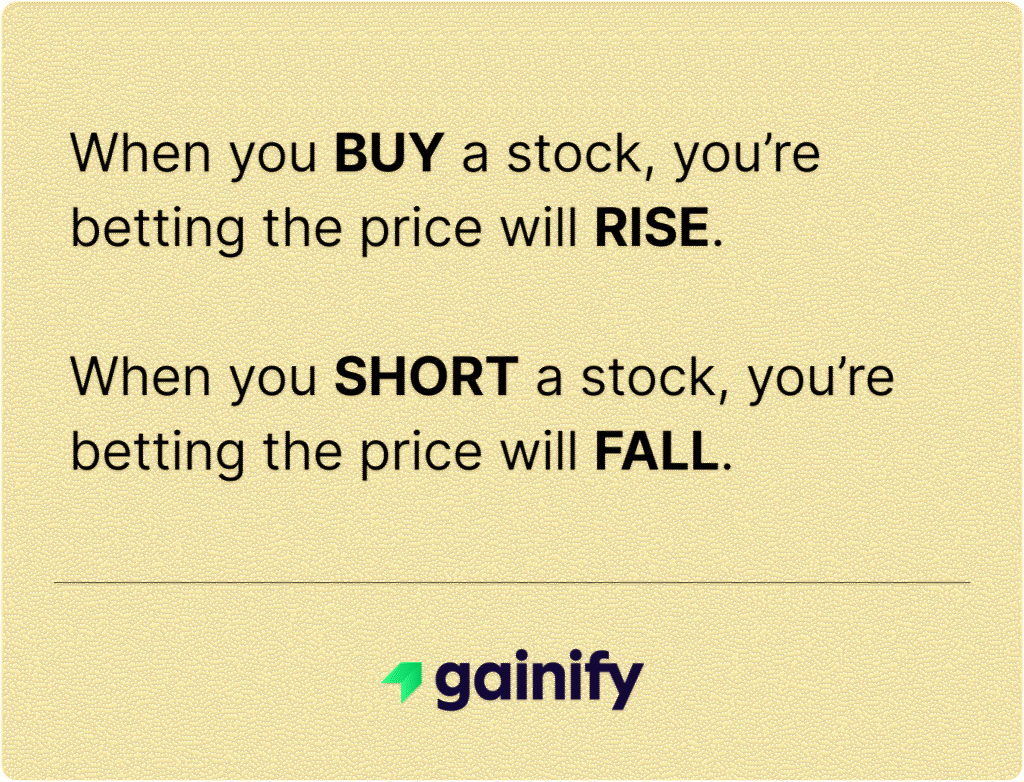Shorting a stock might sound intimidating or something reserved for hedge funds, but it’s a fundamental part of modern markets. It allows investors to profit from falling prices, protect gains, or hedge exposure during volatile periods.
In a year like 2025, where AI-driven rallies and macro uncertainty have pushed some stocks to extreme valuations, understanding how to short stocks is more valuable than ever.
Let’s explore what short selling really means, how it works, and when it makes sense, as always step by step.
🌟 Highlights
- Short selling lets investors profit when stock prices decline.
- It involves borrowing shares, selling them, and buying back later at a lower price.
- Margin, borrowing fees, and timing are critical to manage.
- Common tools include direct shorts, put options, and inverse ETFs.
- Losses can be unlimited, so strict risk control is essential.
- Shorting can serve as a hedge during market corrections or bubbles.
What Does It Mean to Short a Stock?

When you buy a stock, you’re betting the price will rise.
When you short a stock, you’re betting the price will fall.
In simple terms, shorting is the act of borrowing shares from a broker, selling them immediately, and later buying them back (hopefully at a lower price) to return to the lender.
Your profit or loss comes from the difference between the price you sell the borrowed shares for and the price you later buy them back at.
Example:
You short 100 shares of a company trading at $100 each, selling them for a total of $10,000.
- If the price falls to $80, you buy the shares back for $8,000 and make a $2,000 profit (before fees).
- If the price climbs to $120, buying them back costs $12,000, resulting in a $2,000 loss.
In short, you profit when the stock falls and lose money when it rises — the exact opposite of traditional investing.
How Short Selling Works Behind the Scenes
Step 1: Enable margin trading
To short a stock, you must have a margin account, as a standard cash account won’t work.
Go into your broker’s app settings and turn on margin trading (it often requires identity verification and risk acknowledgment).
Most brokers require at least $2,000 in equity, but some, like Interactive Brokers, may ask for more depending on your short position size.
Step 2: Check if the stock can be shorted
Not every stock is shortable.
In your trading app, search for the ticker and check the “short availability” indicator:
- Easy to borrow – shares are plentiful and cheap to borrow.
- Hard to borrow – few shares available, with higher borrow fees.
Step 3: Review costs before shorting
Before placing your trade, check:
- Borrow rate (daily interest to borrow shares).
- Margin interest (applies to any borrowed cash).
- Potential dividend obligations (if the stock pays one).
These costs reduce your profit, so factor them into your position size and holding period.
Step 4: Place a “Sell Short” order
Now enter your trade just like a regular stock order:
- Select the stock.
- Choose Sell or Sell Short.
- Set number of shares and order type (market or limit).
- Confirm the trade.
The broker borrows the shares automatically and sells them at the current price. The sale proceeds appear in your margin account but are locked as collateral until you close the trade.
Step 5: Keep your margin healthy
Your account equity must stay above the broker’s maintenance margin, which is usually about 150% of your short position’s value.
If the stock goes up and your margin falls too low, you’ll receive a margin call notification in your app.
You can fix it by:
- Depositing more funds, or
- Closing part of the position.
If you don’t act, your broker will automatically buy back shares to reduce risk (often at a loss).
Step 6: Watch for dividends or corporate events
If you’re short when a company pays a dividend, that dividend doesn’t vanish – you owe it to the share lender.
Also, your broker will adjust your position automatically for any splits, mergers, or spinoffs so you remain even.
Step 7: Monitor your position daily
Track your short’s performance and costs using your broker’s dashboard.
Watch for:
- Rising borrow fees (especially if the stock becomes crowded).
- Sudden price spikes or short squeezes.
- Borrow recalls, when lenders demand their shares back.
Step 8: Close the trade (“Buy to Cover”)
When you’re ready to exit:
- Tap Buy to Cover.
- Enter the same number of shares you shorted.
- Confirm the trade.
Your broker buys back the shares in the market and returns them to the lender automatically. If you buy back cheaper than you sold, you profit. If you buy back higher, you lose.
Example:
Short 10 shares at $100 = $1,000 sale.
Buy them back at $80 = $800 cost → $200 profit (minus fees).
Step 9: Review and learn
After settlement (usually two business days), your app updates your realized profit or loss.
Check the trade summary to see:
- Gross profit/loss
- Borrow fees paid
- Margin interest
- Any dividend reimbursements
Use this breakdown to evaluate whether your shorting strategy was cost-efficient, especially if you plan to do it again.
Why Investors Short Stocks
Shorting isn’t only about betting against companies. It’s also a powerful hedging and portfolio management tool used by professionals.
Common reasons include:
- Profit from overvaluation: When a stock trades far above its fair value or earnings potential.
- Hedging risk: To protect gains in other holdings during market downturns.
- Event-driven trades: To capitalize on catalysts such as earnings misses, lawsuits, or leadership changes.
- Relative value: In pair trades, investors go long on a strong company and short a weaker one in the same industry.
Shorting adds balance and liquidity to markets, allowing investors to express both optimism and caution.
Common Ways to Short a Stock
1. Traditional Short Selling
The most direct approach. You borrow shares, sell them, and repurchase later. It provides full downside exposure but carries unlimited risk if prices rise significantly.
2. Put Options
A put option gives you the right to sell a stock at a fixed price within a set time. It limits your losses to the cost of the option while offering large potential gains if the stock falls sharply.
3. Inverse ETFs
These exchange-traded funds move opposite to an index or sector. For example, SH shorts the S&P 500 and PSQ shorts the Nasdaq 100. They are easier to trade but best suited for short-term positioning.
4. CFDs (Contracts for Difference)
Common outside the U.S., CFDs let you speculate on price movements without borrowing shares. They are flexible but risky due to leverage and volatility.
⚠️ The Risks of Short Selling
Shorting can be profitable but carries inherently higher risk than traditional investing.
- Unlimited loss potential: Prices can rise indefinitely, unlike long positions capped at 100% loss.
- Short squeezes: When multiple short sellers rush to buy back shares, prices can spike dramatically (e.g., GameStop 2021).
- Borrowing costs: You pay ongoing fees to maintain your short position, which can become expensive in crowded trades.
- Margin calls: A rising stock price can force you to close at a loss if collateral runs short.
- Timing risk: Markets can stay irrational longer than expected, making shorting as much about patience as conviction.
Short selling requires strict discipline. Always plan entry and exit points, size positions conservatively, and use stop-loss orders where possible.
What to Watch Before Shorting
Before shorting, analyze key indicators and company fundamentals:
- Short interest ratio: High levels can signal crowding and increase squeeze risk.
- Earnings schedule: Avoid shorting before results unless you have deep insight; surprises can be costly.
- Liquidity: Stocks with low daily volume can move violently on little news.
- Valuation and fundamentals: Overpriced stocks with slowing growth or heavy debt loads often make the best short candidates.
- Sentiment and positioning: Excessive optimism, hype, or meme-like enthusiasm often precede reversals.
Successful shorting requires combining technical signals with strong fundamental reasoning – not emotion or headlines.
Final Thoughts
Shorting stocks is not about negativity, but it’s about balance, protection, and timing. It’s a strategy that rewards careful research and strict discipline, not reckless bets.
In 2025’s fast-moving market, short selling helps investors navigate overvalued trends and protect portfolios from sudden reversals. For newcomers, start small, study how margin works, and treat shorting as a tool for risk management, not just speculation.
Handled wisely, it can transform from a fear-driven tactic into a smart, strategic advantage in any investor’s toolkit.




